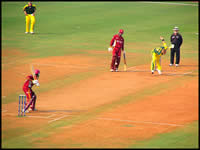Gary's Parries 29/10/06
 This week’s Gary’s Parries topics are:
This week’s Gary’s Parries topics are:
1. Panasonic FZ50’s Noisy CCD, It’s Just Not Cricket
2. How Do Add-On Lenses Effect DOF?
Introducing this week’s Gary’s Parries column. Everything you always wanted to know about digital cameras, but were afraid to ask. No question too difficult, or too easy. As a Senior Principal Software Engineer, and a former Assistant Professor of Computer Information Systems, as well as a recording studio owner/operator, inventor, and now, a digital camera enthusiast, GARY has more digital camera knowledge in his entire brain than most people have in their little finger. In the unlikely event that GARY would not know the answer to your question, he will answer it anyway, true to the spirit of the word “Parries”, a fencing term which, in this context, implies “cleverly evasive answers”. So let your imagination run wild. Email all your nagging digital camera questions to: [email protected] , and then, En Garde!
You may also attach to your email an ORIGINAL PHOTO of your choosing. A preview of the photo will be displayed with your question, and a full-sized version will be just a click away. No personal information will be published with your question unless you specifically include it in the text or attached photo of your email, which may be further edited for grammar, content, or other reasons.
***
*** QUESTION 1—- PANASONIC FZ50’S NOISY CCD, IT’S JUST NOT CRICKET
***
I am a young amateur photographer who hopes to be able to call himself an enthusiast someday. I currently use a Canon PowerShot S1 IS. Though it has a great feature set and sufficient megapixels for my applications (I usually never print larger than 8 x 10 inches), I find its response rather slow and its shutter lag high. Also, its manual focus is a pain to use, and its movie mode, like many other Canon cameras, is very granular.
I recently fell in love with the handling and features of the Panasonic Lumix DMC-FZ50, but I am disappointed by its high image noise. Many reviews say that its 10-megapixel rating is of little use for printing large pictures due to a noisy CCD. Its movie mode was head and shoulders above other Canon & Kodak cameras I have tested, and its intuitive menu system and well thought-out controls make it a pleasure to use. The optional wide-angle converter and choice of aspect ratios are a breath of fresh air. Why can’t Panasonic release an FZ50 with a low-noise Fuji SuperCCD?
Why don’t more camera manufacturers record movies in DivX format for compression sake? Many of today’s DVD players support it. If they allow sufficiently long video on digicams, they could probably kill the amateur handy-cam market. Being able to carry one device that is great for photos and decent for videos would do the trick for many.
When examining the movie mode specifications of a camera, I think it is essential for the manufacturer to mention how long the battery lasts at the highest resolution. What is the point of being able to record a 2GB video if your battery drains completely after filling up 800MB? Would you happen to know the length of time a freshly charged battery will last in the FZ50’s video mode? It could perhaps save me the cost of 4GB cards. I wish camera companies were more forthcoming with this bit of information.
I am an engineering student, but photography is my passion. The Panasonic FZ50 is a very unique offering that many amateurs on a shoestring budget (like me) would love to possess, but we cannot afford to sink our money into a brilliant camera with a noisy CCD.
I hope you can find the time to kindly answer this long email.
Thanking you.
Yours truly,
Aditya Govindarajan
***
*** ANSWER 1
***
AG, judging from the level of your questions about digital cameras, it sounds to me like you are ‘already’ an enthusiast.
Regarding the specs you requested about the Panasonic Lumix DMC-FZ50’s battery life in video mode, unfortunately, I do not have that information. Maybe one of our readers with an FZ50 will be kind enough to check for you. I am sure others would be interested, as well.
Regarding the FZ50’s unacceptably noisy image sensor, as has been reported by every reviewer (with the possible exception of CNET’s Philip Ryan who, in his FZ50 Review, cleverly pointed out that the FZ50 is NOT as noisy as some of Panasonic’s ‘other’ camera models :)), I can certainly sympathize with you, as the camera is nearly perfect in every other respect. It’s just not cricket, AG.
Your idea of replacing the FZ50’s noisy CCD with a low-noise, Fuji SuperCCD, is a good one from a technological standpoint, but not so good from a marketing standpoint. Panasonic needs to differentiate the FZ50 from entry-level DSLRs by having a clearly lower price point compared to DSLRs. Adding a Fuji SuperCCD would only make this already difficult task nearly impossible.
As for your question about more camera manufacturers utilizing the DivX video format, with that I can help. Where there was previously only one such manufacturer, Pentax, with its Optio S6 (the first ever DivX camera), and then later with its Optio A10, S7, and A20 models, now there is a second manufacturer, Casio, with its Zoom EX-S600D. Can Panasonic be far behind?
P.S. Your Canon PowerShot S1 IS did a superb job with this cricket action shot from the ICC Champions Trophy - 4th Match : Australia vs. West Indies at Brabourne Stadium in Mumbai. (I hope you were rooting for West Indies, who won by 10 runs.)
***
*** QUESTION 2—- HOW DO ADD-ON LENSES EFFECT DOF?
***
In comment #5 of the October 15, 2006 Gary’s Parries, you eloquently explained how add-on lenses attached between the camera body and lens affect a camera lens’ f-stop differently from add-ons attached to the front of the camera lens. As a result of your clear and simple explanation, I now understand this phenomenon completely, and I was hoping you could provide a similar explanation for the effect of add-on lenses on depth of field?
Thank you in advance for your excellent response.
Regards,
Paris
***
*** ANSWER 2
***
Paris, did you happen to read comment #7 from that very same Gary’s Parries, where I specifically expressed gratitude that no one had asked me about the effect of add-on lenses with respect to DOF? :)
The reason I was reluctant to answer that question is because of the abundance of misinformation out there on the subject of DOF … to which, hopefully, this will not add.
When a lens is focused on a subject, the only points on the subject that will appear as single points on its image are those that are located at the precise focus distance of the lens. Points that are located near the lens focus distance will appear on an image as small circles (of confusion), rather than as single points. This is caused mainly by lens aberrations (mostly spherical aberrations as a result of the curved surfaces of the lens) that diffuse the points of light, and to a lesser extent, by diffraction of the light rays as they pass through the lens shutter.
If the resulting circles of confusion are sufficiently small, they will still be perceived as single image points by the eye. However, as the points of a subject become increasingly separated from the lens focus distance, their circles of confusion become increasingly large, which causes them to appear out of focus to the eye. This is where the concept of depth of field comes into play.
The total depth of field for an image is defined as the distance along the optical axis of the lens from the closest point of the subject that appears in focus to the farthest point of the subject that appears in focus. For example, if the leaves of a tree start to appear in focus at 10 feet from the lens, and then start again to appear out of focus after 15 feet from the lens, the total depth of field for that image is 15 - 10 = 5 feet.
In order to understand the effect that add-on lenses will have on DOF, we need to make some assumptions. For the purposes of simplification, we will assume that our add-on lenses are ideal lenses (i.e., no aberrations of their own). We will also assume that our subject distance is within 1/4 of the hyperfocal distance (look it up) of the camera lens.
With these simplifications in place, I can now make the highly controversial claim that the focal length of a lens has NO effect on DOF. For example, when using a camera’s Aperture Priority mode with a 10x (28 - 280mm) zoom lens, if you observe the DOF of an image with the zoom lens set for 28mm at f/8 while focused on a subject 4 feet away, and then compare it with the DOF of an image with the zoom lens set for 280mm at f/8 while focused on the same subject, but from 40 feet away (thereby producing the same subject size for the two images), the DOF of the two images will also be the same.
If you’re still with me after that trying last paragraph, you are now ready to accept the fact that DOF is affected ONLY by the physical aperture settings of the lens. The reason for this is simple. When an aperture is adjusted wide open, light from the entire face of the lens is passed through to strike the image sensor. As the aperture is made smaller, light passing through the outer edges of the lens is blocked from the image sensor. At the smallest aperture of the lens, all light is blocked except that which passes through the very center of the lens.
As ‘luck’ would have it, the center of a lens has the fewest aberrations. Stopping down a lens (i.e., ‘physically’ decreasing its aperture) blocks the ‘bad’ light from the edges of the lens and passes the ‘good’ light from the center of the lens; hence, it is the lens aperture that determines an image’s circle of confusion size, which in turn determines its DOF.
If you recall from our previous discussion of the two types of add-on lenses in comment #5 of the October 15, 2006 Gary’s Parries, the type that attaches between the camera body and lens will multiply the camera lens’ f-stop by the add-on lens’ magnification factor, whereas the type that attaches to the front of a camera lens will have no effect on the camera lens’ f-stop. So you might think that the former type of add-on lens would also multiply an image’s DOF by the add-on’s magnification factor, in which case, you would be wrong.
An add-on lens does not change the ‘physical’ aperture of a camera lens, and it is the reduction of the physical aperture that has the effect of directing light through the lens center to minimize an image’s circle of confusion, and thereby maximize its DOF. So, as you can see, with both types of add-on lenses, there will be no effect on DOF (again, assuming the simplifications previously discussed.)
Paris, hope that clears things up for you. Now please, DO NOT ask me about the effect that add-on lenses will have on ‘bokeh’. :)
[Note: Much thanks to Nick in Japan for submitting this family outing photo of his son and two daughters. Nick, you must be a good family man. Your family always looks so happy. – Ed.]
***
[Column photo “The Photographer” by Brenda LaFleur of Brenda LaFleur Photography.]


